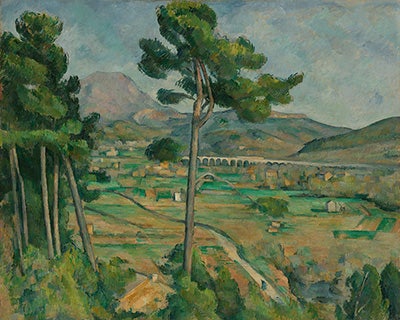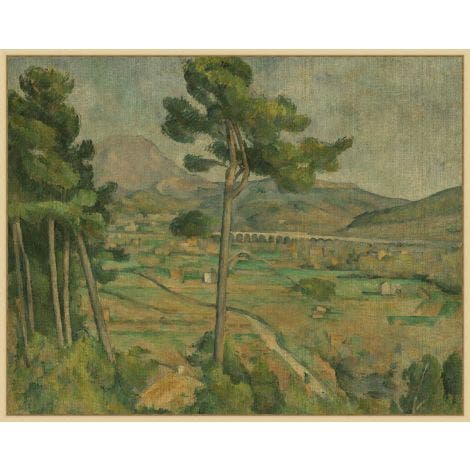Local Storage seems to be disabled in your browser.
For the best experience on our site, be sure to turn on Local Storage in your browser.
Scene of the Arc River Valley

This Met x Wendover Art Group design is a reproduction of an original work of art in The Metropolitan Museum of Art collection.
Mont Sainte-Victoire and the Viaduct of the Arc River Valley
Paul Cézanne (French, 1839–1906)
Oil on canvas, 25 3/4 x 32 1/8 in., 1882–85
H. O. Havemeyer Collection,
Bequest of Mrs. H. O. Havemeyer, 1929 29.100.64
The distinctive silhouette of Mont Saint-Victoire rises above the Arc River valley near the town of Aix. To paint this scene, Cézanne stood close to Montbriand, his sister’s property, at the top of the hill just behind her house. Cézanne sought to reveal the inner geometry of nature, “to make of Impressionism something solid and durable, like the art of museums.” Indeed, the railroad viaduct that cuts through this pastoral scene is evocative of a Roman aqueduct, recalling paintings by Nicolas Poussin.

This Met x Wendover Art Group design is a reproduction of an original work of art in The Metropolitan Museum of Art collection.
Mont Sainte-Victoire and the Viaduct of the Arc River Valley
Paul Cézanne (French, 1839–1906)
Oil on canvas, 25 3/4 x 32 1/8 in., 1882–85
H. O. Havemeyer Collection,
Bequest of Mrs. H. O. Havemeyer, 1929 29.100.64
The distinctive silhouette of Mont Saint-Victoire rises above the Arc River valley near the town of Aix. To paint this scene, Cézanne stood close to Montbriand, his sister’s property, at the top of the hill just behind her house. Cézanne sought to reveal the inner geometry of nature, “to make of Impressionism something solid and durable, like the art of museums.” Indeed, the railroad viaduct that cuts through this pastoral scene is evocative of a Roman aqueduct, recalling paintings by Nicolas Poussin.


